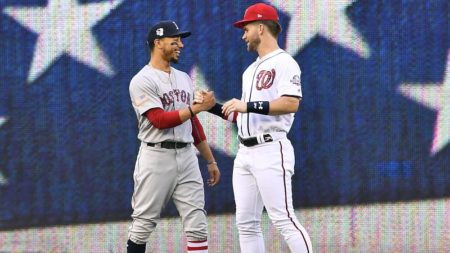Very First All-Star Game Was No “Break” for Participating Players
 Now that we’ve had two straight days of Home Run Derby in our nation’s capital, an unfamilar lull settles in within MLB. No games will be played on Wednesday, as per custom, and only one primetime game is scheduled for Thursday night. Fortunately, we won’t see this type of baseball drought again until the end of the regular season.
Now that we’ve had two straight days of Home Run Derby in our nation’s capital, an unfamilar lull settles in within MLB. No games will be played on Wednesday, as per custom, and only one primetime game is scheduled for Thursday night. Fortunately, we won’t see this type of baseball drought again until the end of the regular season.
But it wasn’t always this way. The first All-Star Game was the brainchild of Arch Ward, a sports writer for the Chicago Tribune who envisioned a one-time spectacle called “The Game of the Century.” Chicago was hosting the World’s Fair in 1933, known as the “Century of Progress Exhibition.” It made sense to make use of the Century theme, as the game was intended to be baseball’s contribution to the Exhibition.
The Great Depression was in full swing in 1933, and both attendance and player salaries were in decline. The Tribune sponsored the game and paid all expenses, without which the event may never have happened. But the schedule for the 1933 season had already been set when the game was first announced in May. It was determined that Ward’s game should be played around the Fourth of July, but not on that date itself because all of MLB’s 16 teams already had doubleheaders scheduled. To understand what happened next requires a bit of a crash course in 1930s baseball geography.
In 1933, there were no divisions as we think of them today, but there was a definite split within both leagues between Eastern teams and Western teams. And no, the California and Seattle teams weren’t considered “Western” back them. St. Louis was as far west as the majors extended in those days.
The Eastern teams in the National League were the New York Giants, Brooklyn Dodgers, Philadelphia Phillies and Boston Braves, while the Western teams were the Chicago Cubs, St. Louis Cardinals, Pittsburgh Pirates and Cincinnati Reds. In the American League, the split was the New York Yankees, Boston Red Sox, Philadelphia Athletics and Washington Senators in the East, and the Chicago White Sox, Detroit Tigers, St. Louis Browns, and Cleveland Indians in the West.
For some parts of the season, an Eastern team played another Eastern team, as when the Phillies played the Braves in Boston. For other parts of the season, an Eastern team traveled to play teams in the West, such as when the Senators played the Tigers in Detroit. There was no interleague play, and travel by airplane was still years away. The teams traveled by train, and they had to do it judiciously to make ends meet.
The Fourth of July doubleheaders in 1933 were all Eastern teams playing against other Eastern teams, or two Western teams playing against each other, perhaps for regional rivalries and perhaps to keep all of the teams relatively close to their home base. But after The Fourth, the teams began what was called “the exchange,” with Western teams traveling east, or vice versa. This created a scheduling opportunity to squeeze in a one-time exhibition in Chicago, which was all the game ever intended to be.
A fair number of players had games scheduled on Wednesday, July 5, against the teams they had played doubleheaders against the day before. The Cardinals’ Pepper Martin, Frankie Frisch, Jimmie Wilson and Bill Hallahan—who all started the All-Star Game for the National League the following day—played against the Pirates in Pittsburgh, then boarded a train for Chicago for the Game of the Century. They then rode another train to St. Louis following the All-Star Game to play a home game against the Dodgers. Chicago and St. Louis aren’t that far apart geographically, but playing three games in three different cities in three days sounds exhausting for anyone.
Likewise, the Chicago White Sox—who hosted the game by virtue of winning a coin toss against the Cubs—had two of their best players endure a strange trip of their own. Al Simmons and Jimmy Dykes played in Cleveland on July 5, they then boarded a train for Chicago for the special one-off exhibition game, and then rode a train eastbound to Philadelphia to play the Athletics the next day. Detroit’s Charlie Gehringer played in St. Louis against the Browns on July 5, then rode a train to Chicago on July 6, and then went east to play in New York on July 7. The recognition for these players for being chosen to play in the game must have been very nice, but the travel involved was probably something else.
But not all of the players had it so bad. The Yankees’ contingent of Babe Ruth, Lou Gehrig, Ben Chapman and Lefty Gomez had an off day on July 5 after playing a doubleheader at home on The Fourth, and were back in New York on July 7. The day after playing in Chicago, Ruth was 2-for-4 and hit a home run against the visiting Detroit Tigers. And let’s remember that Ruth famously hit the first All-Star Game home run in 1933, so the travel didn’t seem to bother him too much.
Here’s hoping that the players, fans and everyone associated with the game enjoys the next two days off. And then it’s on to the rest of the regular season and the playoffs.


























